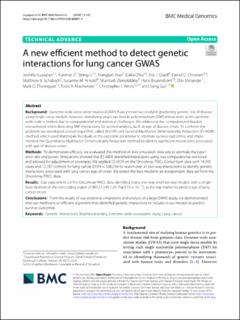| dc.description.abstract | Background Genome-wide association studies (GWAS) have proven successful in predicting genetic risk of disease using single-locus models; however, identifying single nucleotide polymorphism (SNP) interactions at the genome-wide scale is limited due to computational and statistical challenges. We addressed the computational burden encountered when detecting SNP interactions for survival analysis, such as age of disease-onset. To confront this problem, we developed a novel algorithm, called the Efficient Survival Multifactor Dimensionality Reduction (ES-MDR) method, which used Martingale Residuals as the outcome parameter to estimate survival outcomes, and implemented the Quantitative Multifactor Dimensionality Reduction method to identify significant interactions associated with age of disease-onset. Methods To demonstrate efficacy, we evaluated this method on two simulation data sets to estimate the type I error rate and power. Simulations showed that ES-MDR identified interactions using less computational workload and allowed for adjustment of covariates. We applied ES-MDR on the OncoArray-TRICL Consortium data with 14,935 cases and 12,787 controls for lung cancer (SNPs = 108,254) to search over all two-way interactions to identify genetic interactions associated with lung cancer age-of-onset. We tested the best model in an independent data set from the OncoArray-TRICL data. Results Our experiment on the OncoArray-TRICL data identified many one-way and two-way models with a single-base deletion in the noncoding region of BRCA1 (HR 1.24, P = 3.15 × 10–15), as the top marker to predict age of lung cancer onset. Conclusions From the results of our extensive simulations and analysis of a large GWAS study, we demonstrated that our method is an efficient algorithm that identified genetic interactions to include in our models to predict survival outcomes. | |
